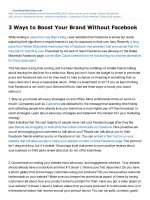301 ways to use social media to boost your marketing
Bạn đang xem bản rút gọn của tài liệu. Xem và tải ngay bản đầy đủ của tài liệu tại đây (1.64 MB, 352 trang )
301
WAYS TO USE
SOCIAL
MEDIA TO
BOOST YOUR
MARKETING
This page intentionally left blank
301
WAYS TO USE
SOCIAL
MEDIA TO
BOOST YOUR
MARKETING
CATHERINE PARKER
New York Chicago San Francisco Lisbon London Madrid Mexico City
Milan New Delhi San Juan Seoul Singapore Sydney Toronto
Copyright © 2011 by Catherine Parker. All rights reserved. Except as permitted under the United States
Copyright Act of 1976, no part of this publication may be reproduced or distributed in any form or by any means,
or stored in a database or retrieval system, without the prior written permission of the publisher.
ISBN: 978-0-07-173989-4
MHID: 0-07-173989-0
The material in this eBook also appears in the print version of this title: ISBN: 978-0-07-173904-7,
MHID: 0-07-173904-1.
All trademarks are trademarks of their respective owners. Rather than put a trademark symbol after every
occurrence of a trademarked name, we use names in an editorial fashion only, and to the benefit of the trademark
owner, with no intention of infringement of the trademark. Where such designations appear in this book, they have
been printed with initial caps.
McGraw-Hill eBooks are available at special quantity discounts to use as premiums and sales promotions, or for
use in corporate training programs. To contact a representative please e-mail us at
This publication is designed to provide accurate and authoritative information in regard to the subject
matter covered. It is sold with the understanding that the publisher is not engaged in rendering legal, accounting,
securities trading, or other professional services. If legal advice or other expert assistance is required, the services
of a competent professional person should be sought.
—From a Declaration of Principles Jointly Adopted by a Committee of the American Bar Association and a
Committee of Publishers and Associations
TERMS OF USE
This is a copyrighted work and The McGraw-Hill Companies, Inc. (“McGrawHill”) and its licensors reserve all
rights in and to the work. Use of this work is subject to these terms. Except as permitted under the Copyright Act
of 1976 and the right to store and retrieve one copy of the work, you may not decompile, disassemble, reverse
engineer, reproduce, modify, create derivative works based upon, transmit, distribute, disseminate, sell, publish or
sublicense the work or any part of it without McGraw-Hill’s prior consent. You may use the work for your own
noncommercial and personal use; any other use of the work is strictly prohibited. Your right to use the work may
be terminated if you fail to comply with these terms.
THE WORK IS PROVIDED “AS IS.” McGRAW-HILL AND ITS LICENSORS MAKE NO GUARANTEES
OR WARRANTIES AS TO THE ACCURACY, ADEQUACY OR COMPLETENESS OF OR RESULTS TO BE
OBTAINED FROM USING THE WORK, INCLUDING ANY INFORMATION THAT CAN BE ACCESSED
THROUGH THE WORK VIA HYPERLINK OR OTHERWISE, AND EXPRESSLY DISCLAIM ANY WARRANTY, EXPRESS OR IMPLIED, INCLUDING BUT NOT LIMITED TO IMPLIED WARRANTIES OF
MERCHANTABILITY OR FITNESS FOR A PARTICULAR PURPOSE. McGraw-Hill and its licensors do not
warrant or guarantee that the functions contained in the work will meet your requirements or that its operation will
be uninterrupted or error free. Neither McGraw-Hill nor its licensors shall be liable to you or anyone else for any
inaccuracy, error or omission, regardless of cause, in the work or for any damages resulting therefrom. McGrawHill has no responsibility for the content of any information accessed through the work. Under no circumstances
shall McGraw-Hill and/or its licensors be liable for any indirect, incidental, special, punitive, consequential or
similar damages that result from the use of or inability to use the work, even if any of them has been advised of
the possibility of such damages. This limitation of liability shall apply to any claim or cause whatsoever whether
such claim or cause arises in contract, tort or otherwise.
Contents
Acknowledgments
Introduction xvii
xv
1
SOCIAL MEDIA IN ACTION
TIP 1
TIP 2
TIP 3
TIP 4
TIP 5
TIP 6
Think of the bigger picture 3
Use less rather than more 4
Appoint a social media champion 5
Track the effect 6
Take action 7
Keep going 8
2
BLOGGING
Setting Up Your Blog
TIP 7
TIP 8
TIP 9
TIP 10
TIP 11
TIP 12
TIP 13
TIP 14
Decide between a hosted and a self-hosted blog 10
Choose a blogging platform 11
Set up your blog’s look and feel 12
Point your own domain name to your blog 13
Set up an RSS feed 14
Use FeedBurner 15
Upload pictures to your post 16
Leverage stats for your blog 17
Writing Useful Blog Content
TIP 15 It’s about your readers, not you 18
TIP 16 Carve out a niche 19
v
TIP 17
TIP 18
TIP 19
TIP 20
TIP 21
TIP 22
Know your subject matter 20
Write viral content 21
Avoid the jargon 22
Don’t be self-contained 23
Experiment, track, and respond 24
Encourage audience interaction 25
Attracting a Loyal Reader Base to Your Blog
TIP 23
TIP 24
TIP 25
TIP 26
Let people know about you 26
Write regularly 27
Use your blog to handle criticism 28
Become a guest blogger 29
Making Your Blog Best Friends with Search Engines
TIP 27
TIP 28
TIP 29
TIP 30
TIP 31
TIP 32
Check that you’re in Google Search and Google Blog Search 30
How to do keyword research 31
Incorporate keywords into your blog post 32
Tag your blog content 33
Attract inbound links to your blog 34
Leverage other communities’ search engine presence 35
Making Money from Your Blog
TIP 33
TIP 34
TIP 35
TIP 36
TIP 37
TIP 38
TIP 39
Understand Google AdSense 36
Set up Google AdSense 37
Understand Text Link Ads 38
Set up Text Link Ads 39
Write paid reviews 40
Use blog-specific advertising networks 41
Use general affiliate networks 42
Joining Blogging Communities
TIP 40
TIP 41
TIP 42
TIP 43
TIP 44
TIP 45
TIP 46
TIP 47
TIP 48
TIP 49
vi
Participate in blogging communities 43
Submit your blog to directories 44
Join MyBlogLog 45
Network with like-minded communities 46
Add other activities to MyBlogLog 47
Add the “Recent Readers” widget to your blog 48
Leverage MyBlogLog stats 49
Understand Technorati 50
Join Technorati and claim your blog 51
Use Technorati tags 52
CONTENTS
3
MICROBLOGGING
Getting Started on Twitter
TIP 50
TIP 51
TIP 52
TIP 53
TIP 54
TIP 55
TIP 56
TIP 57
TIP 58
TIP 59
TIP 60
TIP 61
TIP 62
TIP 63
TIP 64
Understand Twitter 54
Create your Twitter account 55
Public vs. private accounts 56
Customize your profile 57
Begin tweeting 58
Use URL shorteners 59
Include photographs in your tweets 60
Understand what followers are 61
Find people to follow 62
Reply to followers 63
Retweet 64
Direct messaging 65
Mark favorites 66
Use Twitter search 67
Create lists 68
Leveraging Twitter
TIP 65
TIP 66
TIP 67
TIP 68
TIP 69
TIP 70
TIP 71
TIP 72
TIP 73
TIP 74
TIP 75
Find and track popular hashtags 69
Place hashtags in your tweets 70
Tweet your company blog posts 71
Publicize your account 72
Listen and learn 73
Don’t spam 74
Use real time to your advantage 75
Get your employees involved 76
Use mobile applications 77
Use desktop applications 78
Understand Promoted Tweets 79
FriendFeed
TIP 76
TIP 77
TIP 78
TIP 79
TIP 80
TIP 81
TIP 82
Understand FriendFeed 80
Understand FriendFeed vs. Twitter 81
Set up a FriendFeed account 82
Create updates 83
Aggregate your feeds 84
Create groups in FriendFeed 85
Interact with others 86
CONTENTS
vii
Tumblr
TIP 83
TIP 84
TIP 85
TIP 86
TIP 87
4
Understand Tumblr 87
Start your Tumblr blog 88
Integrate your RSS feed 89
Add Tumblr widgets 90
Use third-party Tumblr services 91
SOCIAL NETWORKING
Facebook Pages
TIP 88
TIP 89
TIP 90
TIP 91
TIP 92
TIP 93
TIP 94
TIP 95
TIP 96
TIP 97
TIP 98
TIP 99
TIP 100
Groups vs. pages 94
Understand Facebook pages 95
Define a reason for your page 96
Create your page 97
Use Facebook applications 98
Keep your page fresh 99
How to get traffic to your Facebook page 100
Analyze your stats 101
Work with existing pages and groups 102
Link to and from your page 103
Feed in your Twitter account 104
Feed in your blog posts 105
Use a Fan Box on other sites 106
Facebook Advertising
TIP 101
TIP 102
TIP 103
TIP 104
TIP 105
TIP 106
TIP 107
TIP 108
Understand Facebook ads 107
Create your Facebook ad 108
Decide which audience to target 109
Understand Facebook advertising cost models 110
Decide on a campaign budget 111
Decide on your ad scheduling 112
Measure your ad performance 113
Optimize your ads 114
TIP 109
TIP 110
TIP 111
TIP 112
TIP 113
TIP 114
viii
Set up your company profile 115
Add a “Share on LinkedIn” widget 116
Join groups 117
Ask and answer questions 118
Leverage your personal profile 119
Use LinkedIn search 120
CONTENTS
Orkut
TIP 115
TIP 116
TIP 117
TIP 118
TIP 119
TIP 120
Understand Orkut 121
Join Orkut 122
Add scraps and updates 123
Engage users on brand community pages 124
Enroll in Orkut Promote 125
Track and improve your ads 126
Plaxo
TIP 121
TIP 122
TIP 123
TIP 124
TIP 125
TIP 126
TIP 127
Understand Plaxo 127
Set up your Plaxo profile 128
Use the Plaxo address book 129
Add connections 130
Use Pulse 131
Enable feeds from other services 132
Create groups 133
Ning
TIP 128
TIP 129
TIP 130
TIP 131
TIP 132
TIP 133
Understand Ning 134
Create your Ning network 135
Collaborate with other industry members 136
Encourage the conversation 137
Manage your network effectively 138
Market your network externally 139
MySpace
TIP 134
TIP 135
TIP 136
TIP 137
TIP 138
TIP 139
TIP 140
TIP 141
TIP 142
TIP 143
Decide whether MySpace is right for your business 140
Set up your profile 141
Find friends 142
Create fresh content 143
Join groups 144
Add value 145
Use MySpace Advertising 146
Create your ad 147
Learn from your advertising analytics 148
Experiment based on stats 149
Meetup
TIP 144
TIP 145
TIP 146
TIP 147
Understand Meetup 150
Search for existing groups 151
Create a new group 152
Hold regular meetups 153
CONTENTS
ix
TIP 148 Promote your group 154
TIP 149 Sponsor a group 155
5
SOCIAL BOOKMARKING
Delicious
TIP 150
TIP 151
TIP 152
TIP 153
TIP 154
TIP 155
TIP 156
TIP 157
TIP 158
Understand Delicious 158
Create your account 159
Start bookmarking content 160
Network with other users 161
Write Delicious content 162
Encourage users to bookmark your content 163
Subscribe to tags 164
Mine Delicious for content ideas 165
Be an influential user 166
Digg
TIP 159
TIP 160
TIP 161
TIP 162
TIP 163
TIP 164
TIP 165
TIP 166
TIP 167
TIP 168
Understand Digg 167
Customize your profile 168
Install the Digg toolbar 169
Submit stories strategically 170
Write a good title and description 171
Make it easy to Digg your content 172
Network with other Digg users 173
Be active 174
Be discerning 175
Use Digg advertising 176
StumbleUpon
TIP 169
TIP 170
TIP 171
TIP 172
TIP 173
TIP 174
TIP 175
TIP 176
TIP 177
Understand StumbleUpon 177
Connect directly with other users 178
Find new stumblers 179
Make your page “stumble-worthy” 180
Increase your content’s popularity 181
Retain your StumbleUpon traffic 182
Submit other useful content 183
Pay for sponsored stumbles 184
Track and improve your sponsored stumbles 185
Google Reader
TIP 178 Understand Google Reader 186
TIP 179 Subscribe to other feeds and people 187
x
CONTENTS
TIP 180 Select those to share items with 188
TIP 181 Build your readership 189
TIP 182 Share posts in other services 190
TIP 183
TIP 184
TIP 185
TIP 186
TIP 187
TIP 188
TIP 189
TIP 190
TIP 191
TIP 192
6
Understand Reddit 191
Get started on Reddit 192
Submit content 193
Build up karma 194
Post to subreddits 195
Get your content noticed 196
Encourage others to post your content 197
Make friends 198
Post good content 199
Leverage your existing network 200
MULTIMEDIA
Flickr
TIP 193
TIP 194
TIP 195
TIP 196
TIP 197
TIP 198
TIP 199
TIP 200
TIP 201
TIP 202
TIP 203
TIP 204
TIP 205
TIP 206
TIP 207
Understand Flickr 202
Write your profile 203
Upload photos 204
Promote your account 205
Join groups 206
Create your own group 207
Promote your group 208
Add a Flickr badge 209
Decide between a free and a pro account 210
Use Flickr images for your blog content 211
Analyze your stats 212
Don’t spam 213
Share quality photos 214
Think about search engines 215
Control how your photos are shared 216
SmugMug
TIP 208
TIP 209
TIP 210
TIP 211
TIP 212
TIP 213
Understand SmugMug 217
Sign up and customize 218
Upload photos 219
Optimize your photos 220
Share your photos 221
Join communities 222
CONTENTS
xi
Video-Sharing Sites
TIP 214
TIP 215
TIP 216
TIP 217
TIP 218
TIP 219
TIP 220
TIP 221
TIP 222
Understand the video landscape 223
It’s all about the content 224
Keep best practices in mind 225
Share your videos 226
Use Metacafe 227
Use Yahoo! Video 228
Use Viddler 229
Use Vimeo 230
Use TubeMogul to submit videos 231
YouTube
TIP 223
TIP 224
TIP 225
TIP 226
TIP 227
TIP 228
TIP 229
TIP 230
TIP 231
TIP 232
TIP 233
TIP 234
TIP 235
TIP 236
Understand YouTube 232
Create a channel 233
Create a custom channel 234
Think about search engines 235
Tag your videos 236
Upload your videos 237
Create a call to action 238
Leverage video responses 239
Share videos 240
Build subscribers 241
Participate in the community 242
Use Google AdWords 243
Understand Promoted Videos 244
Create Promoted Videos 245
SlideShare
TIP 237
TIP 238
TIP 239
TIP 240
TIP 241
TIP 242
TIP 243
TIP 244
Understand SlideShare 246
Create a SlideShare account 247
Create good content 248
Upload presentations 249
Use LeadShare 250
Use AdShare 251
Join groups 252
Promote your profile externally 253
Podcasting
TIP 245
TIP 246
TIP 247
TIP 248
xii
Understand podcasting 254
Research topics 255
Create your podcast 256
Create your podcast RSS feed 257
CONTENTS
TIP 249
TIP 250
TIP 251
TIP 252
7
Optimize for search engines 258
Upload your podcast 259
Submit to podcast directories 260
Market your podcast 261
REVIEWS AND OPINIONS
Reviews and Opinions Overview
TIP 253 Respond to positive reviews 265
TIP 254 Respond to negative reviews 266
Yelp
TIP 255
TIP 256
TIP 257
TIP 258
TIP 259
TIP 260
Understand Yelp 267
Claim your profile 268
Solicit reviews 269
Use your account information 270
Get involved with the community 271
Respond publicly and privately 272
Epinions
TIP 261
TIP 262
TIP 263
TIP 264
TIP 265
TIP 266
Understand Epinions 273
Set up your profile 274
Write and rate reviews 275
Add people to your Web of Trust 276
Become an elevated member 277
Monitor your brand 278
RateItAll
TIP 267
TIP 268
TIP 269
TIP 270
TIP 271
TIP 272
TIP 273
Understand RateItAll 279
Fill out your profile 280
Get your business listed 281
Encourage others to leave reviews 282
Connect with other users 283
Create and share lists 284
Add the consumer review widget 285
Yahoo! Answers
TIP 274
TIP 275
TIP 276
TIP 277
TIP 278
Understand Yahoo! Answers 286
Set up your profile 287
Ask and answer questions 288
Give quality answers 289
Answer relevant questions 290
CONTENTS
xiii
TIP 279 Earn points 291
TIP 280 Be active to be visible 292
TIP 281 Don’t spam 293
eHow
TIP 282
TIP 283
TIP 284
TIP 285
TIP 286
TIP 287
TIP 288
TIP 289
TIP 290
TIP 291
8
Understand eHow 294
Apply with Demand Studios 295
Join eHow 296
Decide on an article topic 297
Drive search traffic to your articles 298
Upload your article 299
Don’t spam 300
Participate in the community 301
Join groups 302
Market your article externally 303
WIKIS
Wikis Overview
TIP 292
TIP 293
TIP 294
TIP 295
TIP 296
Contribute to niche wikis 307
Use wikis internally 308
Choose wiki software 309
Use wikis to communicate with customers 310
Implement wiki processes 311
Wikipedia
TIP 297
TIP 298
TIP 299
TIP 300
TIP 301
Understand Wikipedia 312
Know what to use it for 313
Create a Wikipedia account 314
Start adding and editing content 315
Track what’s being said 316
Notes 317
Index 319
xiv
CONTENTS
Acknowledgments
Many thanks to McGraw-Hill, without whom this book would not be possible, and thanks in particular to Donya Dickerson for her support throughout the project. I am also grateful to Sallie Randolph and Ceridwen Dovey
for their sound advice and guidance at this book’s inception; to Claire Currie
for her friendship and encouragement; and to MJ Otto, Velma Botha, and my
family strewn across the globe for their support and humor as I made my
crossing from marketer to writer.
xv
This page intentionally left blank
Introduction
Toward the end of 2008, Tourism Queensland, Australia’s tourism body for
the country’s second-largest state, was faced with a problem. As a result of
the global financial crisis, people were spending less on international leisure
travel, which for the Australian government meant a threat to the country’s
$88-billion-a-year1 tourist industry. In the tough economic climate, Tourism Queensland wanted to increase tourism revenue to the Great Barrier
Reef islands off the Queensland coast, which would require a completely
new marketing approach, due not least to a shrunken budget. Opportunity
came in the form of Hamilton Island, one of the seventy-four Whitsunday
Islands on the edge of the Great Barrier Reef, which boasts pristine beaches,
immaculate weather, and unspoiled coral reefs. And so, in January 2009,
Tourism Queensland began publicizing its search for someone to be Hamilton Island’s “caretaker”—a career opportunity it dubbed the “Best Job in the
World.” In return for a salary of AUS$150,000 (about $133,000), the successful applicant would work on the island for six months, performing duties
such as feeding the island’s fish, collecting the mail, and “generally enjoying
and exploring the islands of the Great Barrier reef,” all while reporting back
via a blog and video and photo diaries. To apply, interested candidates had
to submit a sixty-second video of themselves making a case for why they
should get the job. Almost immediately the campaign captured the world’s
imagination: within six weeks the campaign website had received around
3.4 million unique visitors and more than thirty-four thousand video applications from 201 countries. The media latched on, too, and the unusual job
advertisement was featured in more than six thousand news stories worldwide, which translated into media coverage valued at over $80 million.
So What Does This Mean for Me?
By anyone’s standards, Tourism Queensland achieved monumental marketing success on a relative shoestring budget. How? Integral to its success was
x vii
the fact that it came up with a truly original idea that piqued people’s interest
at the right time—in the middle of the Northern Hemisphere winter. Then,
to spread its idea, it used social media channels like video sharing and blogging, which allowed it to start a conversation online with people who in turn
spread the message to their own circles of influence. Supplementing this
communication with social media sites like Facebook and Twitter, Tourism
Queensland was able to grow its target audience exponentially and generate enormous buzz about the campaign in a very short span of time and at
relatively little cost.
But how does this apply to you? The Tourism Queensland example is
relevant because no matter what the size of your business or industry,
you can use the same social media strategies to grow your own brand and
increase your customer base. Social media’s accessibility stems largely from
the scalable nature of the Web, as well as the fact that most social media
tools are easy and free to use, so you don’t need special technical skills or
extraordinarily deep pockets to run a successful social media campaign.
With all this in mind, the only real things you need to be successful on the
social media scene are a good strategy and a healthy dollop of time.
So are social media just a collection of websites and tools? On one level,
yes, but they’re also much more than that. At their core, social media can
be defined as uses of Web technology to spread messages through
social interaction that happens online. Put another way, social media
in a business context are ways to spread the word about your brand or
product on the Web using tools and websites that allow a conversation to
take place between you and your target market. Related statistics speak
volumes about the potential of social media to market your brand. For
example, as of early 2010, Facebook has more than four hundred million
users,2 while Twitter was receiving around fifty million updates a day from
its users, which is an average of six hundred tweets per second.3 In other
words, getting involved in the social media space means you’re accessing
a large, active group of people who in turn use these channels to spread
your brand message further. If done correctly, a social media campaign can
result in broad-reaching brand exposure and influence that you’d struggle
to achieve on your own without leveraging an online community.
Luckily, you don’t have to engage in every social media tactic there is. In
fact, you shouldn’t: no business will be suited to every available tool, and
using all of them would be an unproductive use of your time. For example,
if you’re a film and photography school wanting to market yourself using
social media, sites like Flickr and YouTube will hold a lot more potential for
you than if you sell office supplies. Like all other marketing tactics, the key
to success with social media is to get into the head of your target market to
pinpoint where its members are interacting and then spread your brand’s
x viii
INTRODUCTION
message there. The effort you spend on a social media campaign is only as
good as its success in converting potential customers into real ones, after
all—so it’s worth thinking carefully about who is included in your target
market and where these people are likely to be.
This book aims to reveal the best-kept secret about social media campaigns: they’re surprisingly simple to do. With this major myth debunked, you
can start to pick and choose from various tactics outlined in these pages to
tailor a campaign that’s suited specifically to your business and industry. With
a little effort, your campaign can bring rewards that far outweigh the time you
took to create it. And when this happens, you’ll wonder what took you so long
to start one.
How to Use This Book
To help you create a social media campaign that is best suited to your business, this book organizes the most popular and widely used social media
tools into seven categories: blogging, microblogging, social networking, social bookmarking, multimedia, reviews and opinions, and
wikis. Within each category you’ll find examples of sites and tools—for
example, Twitter and FriendFeed within microblogging tools and Facebook
and LinkedIn within social networking tools.
In each subsection, you’ll find one-page tips that cover one main strategy for that particular tool. Although the tips are structured so that each
one can be read in isolation, you’ll get the most value if you read all the tips
in one section in context with each other. For example, if you read all the
tips on blogging, you’ll be well equipped to create, market, and monetize
your business blog. The tip structure also helps you manage the time commitment that’s part of starting a social media campaign. For example, you
could try reading and implementing one tip every week, which structures
things so you can make steady progress. As you build up your skills, you’ll
be able to implement each of the tips in less time, especially within the same
section. Above all, even if your progress is slow, keep it steady. The best
social media campaigns are built up consistently over time, which allows
your brand’s message to be spread fluidly among others your audience is
connected with.
Finally, it’s important to note that while the contents of this book are
current as of printing, this is unlikely to stay the case for long given the
social media industry’s lightning-fast evolution on almost a daily basis. So
while this book will give you a good basic understanding of social media
principles, it’s impossible to guarantee the ongoing accuracy of all specific
information contained within it.
INTRODUCTION
xix









